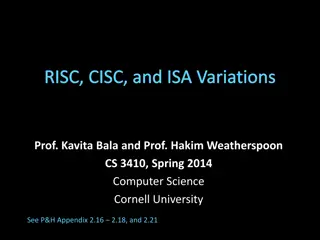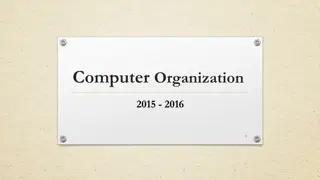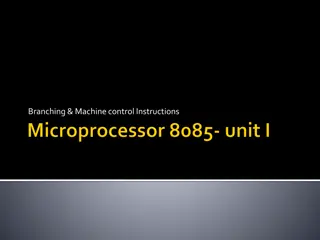Understanding Computer Organization and Architecture
A computer system is a programmable digital electronics device that processes data as per program instructions to provide meaningful output. It comprises hardware and software components, with hardware being the physical parts and software essential for driving the hardware. Computer organization fo
14 views • 71 slides
Understanding MIPS Part II: Memory Organization and Instructions
Explore the intricacies of Memory Organization in the context of MIPS architecture, covering topics such as Memory Transfer Unit, Word Alignment, Load and Store Instructions, Making Decisions with Conditional Branching and Unconditional Jumps, Loops, Arrays and practical exercises. Learn about the m
16 views • 43 slides
Understanding Recipe Essentials for Successful Cooking
Recipes play a crucial role in cooking by providing step-by-step instructions and essential details to recreate a dish accurately. This content delves into key features of a recipe, the importance of following instructions, and the significance of including all ingredients and measurements. It also
9 views • 15 slides
Understanding BCD and ASCII Arithmetic in 8086 Assembly Language
BCD (Binary-Coded Decimal) and ASCII (American Standard Code for Information Interchange) are key concepts in 8086 assembly language for numerical and character manipulations. BCD Arithmetic involves addition and subtraction techniques using instructions like DAA and DAS. The adjustment instructions
1 views • 21 slides
Evolution of IBM System/360 Architecture and Instruction Set Architectures
The IBM System/360 (S/360) mainframe computer system family, introduced in 1964, revolutionized computing by offering forward and backward compatibility, a unified instruction set architecture (ISA), and a balance between scientific and business efficiency. The critical elements of this architecture
1 views • 18 slides
Understanding P&IDs and Symbols in Process Engineering
An insightful primer on P&IDs and symbols for students unfamiliar with EMEC125 and EMEC130 courses. The article delves into the definition of P&IDs as schematic diagrams illustrating the relationship between instruments, controllers, piping, and equipment. It explores the widely understood acronym "
1 views • 32 slides
MIPS CPU Design Using Verilog and Instruction Set Architecture Overview
Explore the world of MIPS CPU design using Verilog with a deep dive into Instruction Set Architecture (ISA), SPIM instruction formats, addressing modes, and more. Learn about the key components such as Program Counter (PC), Instruction Memory (IM), Register Files (RF), Arithmetic Logic Unit (ALU), D
1 views • 29 slides
State of Wisconsin Document Upload and Appointment Scheduling Guide
This comprehensive guide provides step-by-step instructions on how to upload documents for the State of Wisconsin, login to DaySmart Appointments, create interview schedule links for various regions and agencies, obtain the 4-digit schedule ID number, and includes instructions for creating schedule
0 views • 8 slides
Texas Senate Bill 792: Disabled Parking Requirements and Penalties
Texas Senate Bill 792, effective January 1, 2022, outlines the requirements for parking in disabled spaces, including the need for a disabled person license plate or a placard featuring the International Symbol of Access (ISA). Veterans with Disabled Veteran plates must also meet specific criteria t
1 views • 10 slides
Understanding Instruction Set Architecture and Data Types in Computer Systems
In computer architecture, the Instruction Set Architecture (ISA) level is crucial in defining how a processor executes instructions. This includes the formal defining documents, memory models, registers, and various data types that can be supported. The ISA level specifies the capabilities of a proc
2 views • 13 slides
Understanding PIC18 Family Instruction Set and Literal Instructions
Exploring the operation and significance of literal instructions in the PIC18 family's instruction set, including examples of bitwise operations like AND, IOR, and XOR. Learn how these instructions affect the status register and how they can be used to manipulate data effectively in programming with
1 views • 44 slides
IBM System/360 Architecture Evolution
The IBM System/360 (S/360) mainframe computer system family, introduced in 1964, revolutionized computing with its forward and backward compatibility, ISA family concept, and efficient integration of scientific and business applications. The critical elements, including compatibility design consider
0 views • 18 slides
Understanding and Using Imperatives in English
Learn about the difference between requests and instructions, the use of imperatives in various contexts like giving instructions and expressing anger, understanding negative imperatives, and utilizing sequence markers with imperatives to create step-by-step instructions. Explore examples and tips f
1 views • 6 slides
Uncovering Business Models for Linked Government Data
Delve into the exploration of business models for linked government data through a comprehensive study under the European Commission's ISA Programme. Discover key stakeholders, methodologies like the Business Model Canvas, case studies, and the potential value of Linked Open Government Data. Uncover
0 views • 19 slides
Miracles of Prophets: Divine Wonders and Prophetic Signs
Explore the profound significance of miracles in Islam, showcasing the extraordinary events granted by Allah to His Prophets as a testament to their truthfulness and divine approval. Delve into the greatest miracle, the Holy Quran, which offers unparalleled knowledge and insight into the miraculous
2 views • 36 slides
Introduction to Programming and Computer Instructions
Programming is the process of creating instructions for computers to follow and accomplish tasks. It involves turning human language instructions into detailed binary machine language. Before learning programming, individuals may have different levels of experience, ranging from no experience to pro
0 views • 16 slides
Understanding RISC, CISC, and ISA Variations in Computer Science
Explore the differences between RISC and CISC architectures, along with variations in Instruction Set Architecture (ISA). Dive into the intricacies of processor design, performance factors, and assembly languages. Get insights into the concepts of control units, memory units, pipelines, and datapath
0 views • 37 slides
Variations in Computer Architectures: RISC, CISC, and ISA Explained
Delve into the realm of computer architectures with a detailed exploration of Reduced Instruction Set Computing (RISC), Complex Instruction Set Computing (CISC), and Instruction Set Architecture (ISA) variations explained by Prof. Kavita Bala and Prof. Hakim Weatherspoon at Cornell University. Explo
0 views • 55 slides
Exploring Challenges and Opportunities in Processing-in-Memory Architecture
PIM technology aims to enhance performance by moving computation closer to memory, improving bandwidth, latency, and energy efficiency. Despite initial setbacks, new strategies focus on cost-effectiveness, programming models, and overcoming implementation challenges. A new direction proposes intuiti
0 views • 43 slides
Practical Implementation of Embedded Shadow Page Tables for Cross-ISA System Virtual Machines
This research focuses on the practical implementation and efficient management of embedded shadow page tables for cross-ISA system virtual machines. It discusses the framework, evaluation, and conclusions regarding system virtualization, particularly addressing memory virtualization overhead and opt
0 views • 33 slides
Contrast and Development in "Men Should Weep" Act Three
Act Three of "Men Should Weep" by Ena Lamont Stewart portrays a contrast in atmosphere from the start of the act, characterized by a cheerier and more positive ambiance. It delves into complex family dynamics, plot strands, and character developments that culminate in a climactic resolution, offerin
0 views • 39 slides
Understanding Unit Cost and the Trunk Formula Technique
Explore the Trunk Formula Technique (TFT) for calculating unit cost based on trunk area, functional limitations, and external considerations. Learn about Basic Reproduction Cost, LCANT, and selecting Unit Cost for various scenarios and regions like ISA Ontario and PNW Chapter.
0 views • 39 slides
Introduction to Y86 Instruction Set Architecture
Y86 Instruction Set Architecture is a simplified pseudo-language based on x86 (IA-32) architecture. It involves implementing the Fetch-Decode-Execute cycle, where instructions are fetched from memory, decoded, and executed. The Y86 ISA offers a simpler set of instructions and formats compared to x86
0 views • 25 slides
Understanding Computer Organization: Instruction Set Architecture and Interrupts
Explore the critical concepts of Computer Organization focusing on Instruction Set Architecture (ISA) and Interrupts. ISA serves as the interface between hardware and software, enabling programmers to write machine language programs effectively. Learn about Application Binary Interface (ABI), interr
0 views • 26 slides
Understanding X86 ISA Flags in System Security
This article delves into the details of various flags in the X86 ISA architecture, such as CF (Carry Flag), PF (Parity Flag), AF (Auxiliary Flag), ZF (Zero Flag), SF (Sign Flag), TF (Trace Flag), IF (Interrupt Flag), DF (Direction Flag), OF (Overflow Flag), and IOPL (Input Output Privilege Level). T
0 views • 16 slides
Exploring HiAP Implementation for Health Equity
This content explores the implementation of Health in All Policies (HiAP) at local, regional, and global levels, discussing challenges, examples, key results, and conceptual frameworks towards achieving health equity. Various studies and training sessions conducted by WHO and PAHO in collaboration w
0 views • 27 slides
Implementation of RISC-V in Protium: Overview and Analysis
RISC-V, a royalty-free open-source Instruction Set Architecture (ISA), has gained popularity since its inception in 2010. This article delves into the historical background, extensions, integer registers, and the Pulp platform's RISC-V cores. The implementation of RISC-V in Protium is discussed, pro
0 views • 13 slides
Understanding Instrument Air Quality Standards in Industrial Applications
TESCORP, based in Tulsa, Oklahoma, specializes in distributing, fabricating, and servicing compression systems globally. Instrument air quality standards are crucial for pneumatic instruments in various industries. ANSI/ISA 7.0.0.1996 sets the standard for instrument air quality, focusing on pressur
0 views • 17 slides
Understanding the Characters and Themes in "Men Should Weep" by Ena Lamont Stewart
The introduction to the play "Men Should Weep" by Ena Lamont Stewart sets the stage for a tumultuous story as Alec and Isa arrive to stay with John and Maggie after a tragic event. The dynamics between the characters, particularly Alec, Jenny, and the rest of the family, reveal layers of complex rel
0 views • 7 slides
The Life of Sayyidatuna Maryam (alayhassalam) in Islam
Sayyidatuna Maryam (alayhassalam) is renowned in Islam for her piety, purity, and devotion to Allah. Born into the noble family of `Imran, she was granted the honor of being the mother of Prophet `Isa (Jesus). Her miraculous birth and upbringing under Prophet Zakariyyah (alayhissalam) highlight her
0 views • 10 slides
Learning to Interpret Natural Language Navigation Instructions from Observation
This research focuses on developing a system that can interpret natural language navigation instructions by observing humans' actions in a virtual environment. The goal is to create virtual agents capable of understanding and following instructions in video games and educational software, all based
0 views • 51 slides
Ordering of Pseudo Dispatch Instructions for QBOA
This document outlines the specific order in which Pseudo Dispatch Instructions (DIs) are to be arranged for QBOA in scenarios where multiple instructions are issued simultaneously. The order prioritizes certain instructions to maintain consistency and alignment with system implementation rules.
0 views • 11 slides
Understanding Branching and Machine Control Instructions
This content delves into the intricate details of branching and machine control instructions in programming. It explains the three main types of instructions - JUMP (JMP), CALL, and RETURN - along with their subtypes and functionalities. The unconditional and conditional aspects of JUMP, CALL, and R
0 views • 18 slides
Understanding Pipelining in Computer Organization
Explore the intricate process of pipelining in computer organization and assembly language programming. Delve into the fetch-decode-execute cycle, toy ISA instructions, defining pipeline behavior, and the pipeline steps for different instructions. Gain insights into how instructions progress through
0 views • 37 slides
Understanding Advanced Computer Architecture in Parallel Computing
Covering topics like Instruction-Set Architecture (ISA), 5-stage pipeline, and Pipelined instructions, this course delves into the intricacies of advanced computer architecture, with a focus on achieving high performance by optimizing data flow to execution units. The course provides insights into t
0 views • 12 slides
Understanding Arithmetic and Logic Computing in CdM-8
Explore the fundamental concepts of arithmetic and logic computing, including conditions, branches, arithmetic instructions, logic instructions, shift and move instructions, and the practical applications of shift operations. Delve into CdM-8 flags semantics, C and unsigned subtraction/comparison, b
0 views • 14 slides
Overview of Single-Cycle Implementation in Computer Organization
Today's lecture discussed the single-cycle implementation of processors, focusing on executing instructions in hardware based on the ISA. The process involves different cycles such as instruction fetch, decode, execution, memory access, and write-back. The presentation highlighted the functions of a
0 views • 24 slides
Understanding Instruction Set Architectures (ISAs) in Computer Science
Explore the concepts of RISC, CISC, and ISA variations in computer architecture. Dive into the differences between MIPS, ARM, X86, and other ISAs, focusing on load/store, arithmetic, control flow, and more. Gain insights into the evolution and variations of ISAs, and discover the alternatives beyond
0 views • 37 slides
Understanding Different Instruction Formats in Computing
Instruction formats in computing include one-address, two-address, three-address, and zero-address instructions, each with specific ways of specifying operations and operands. One-address instructions utilize an implied accumulator register, while two-address and three-address instructions allow for
0 views • 18 slides
Understanding the IJVM Microarchitecture: Overview and Instruction Set
The IJVM microarchitecture, specifically the Mic-1 microarchitecture, operates using a memory model where no memory addresses are used directly at the ISA level. This model includes areas such as the Constant Pool, Local Variable Frame, Operand Stack, and Method Area. Additionally, the IJVM Instruct
0 views • 10 slides







































